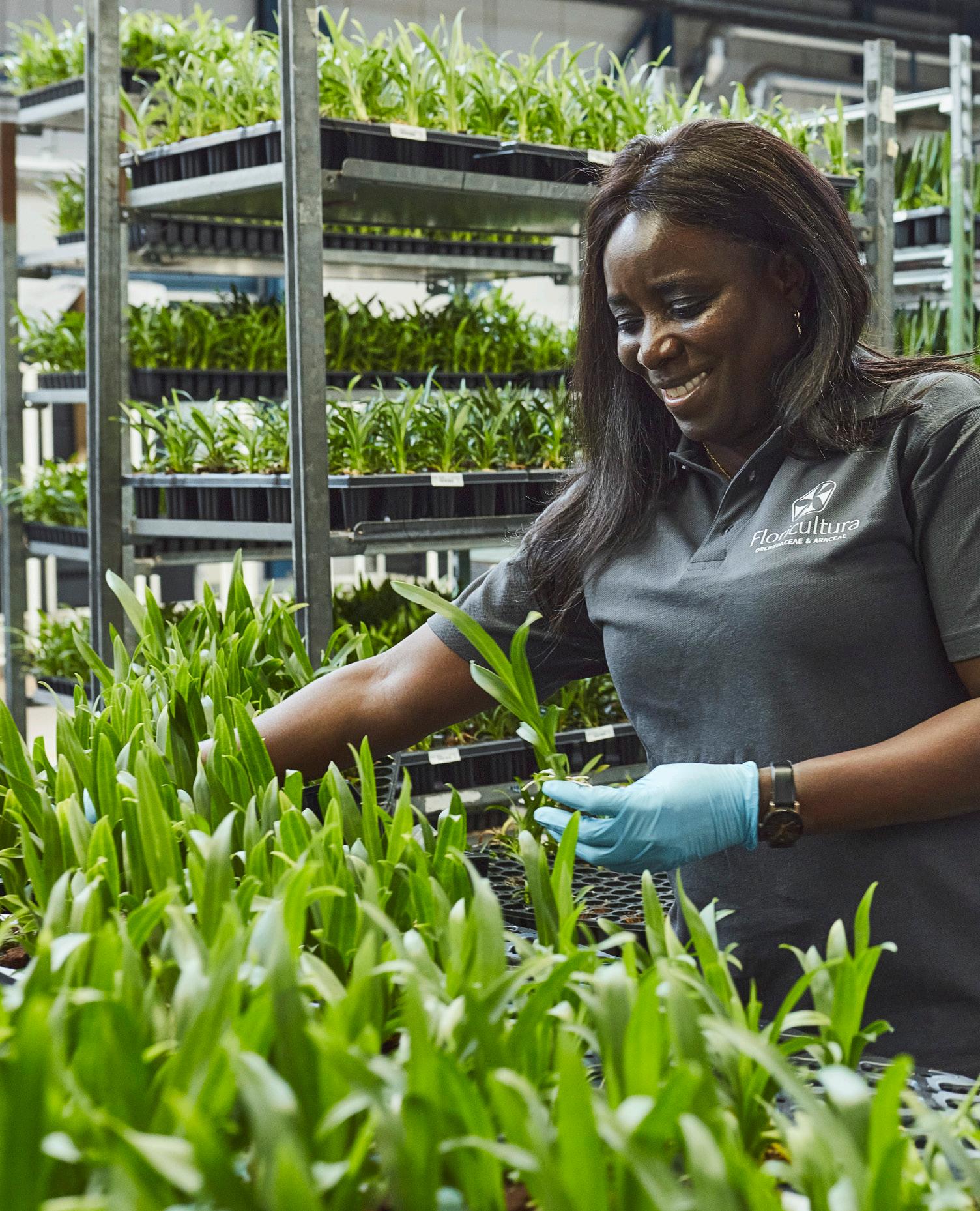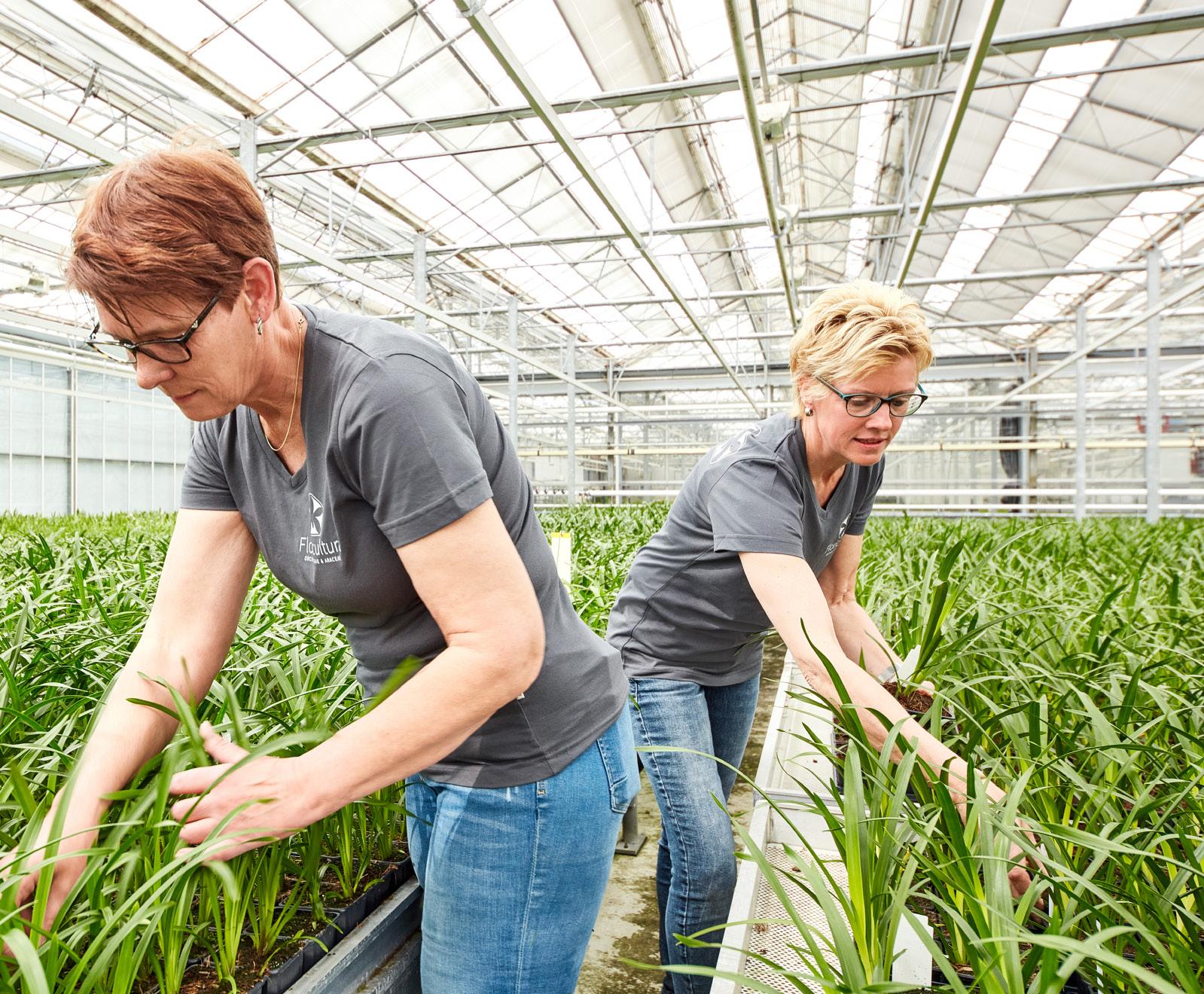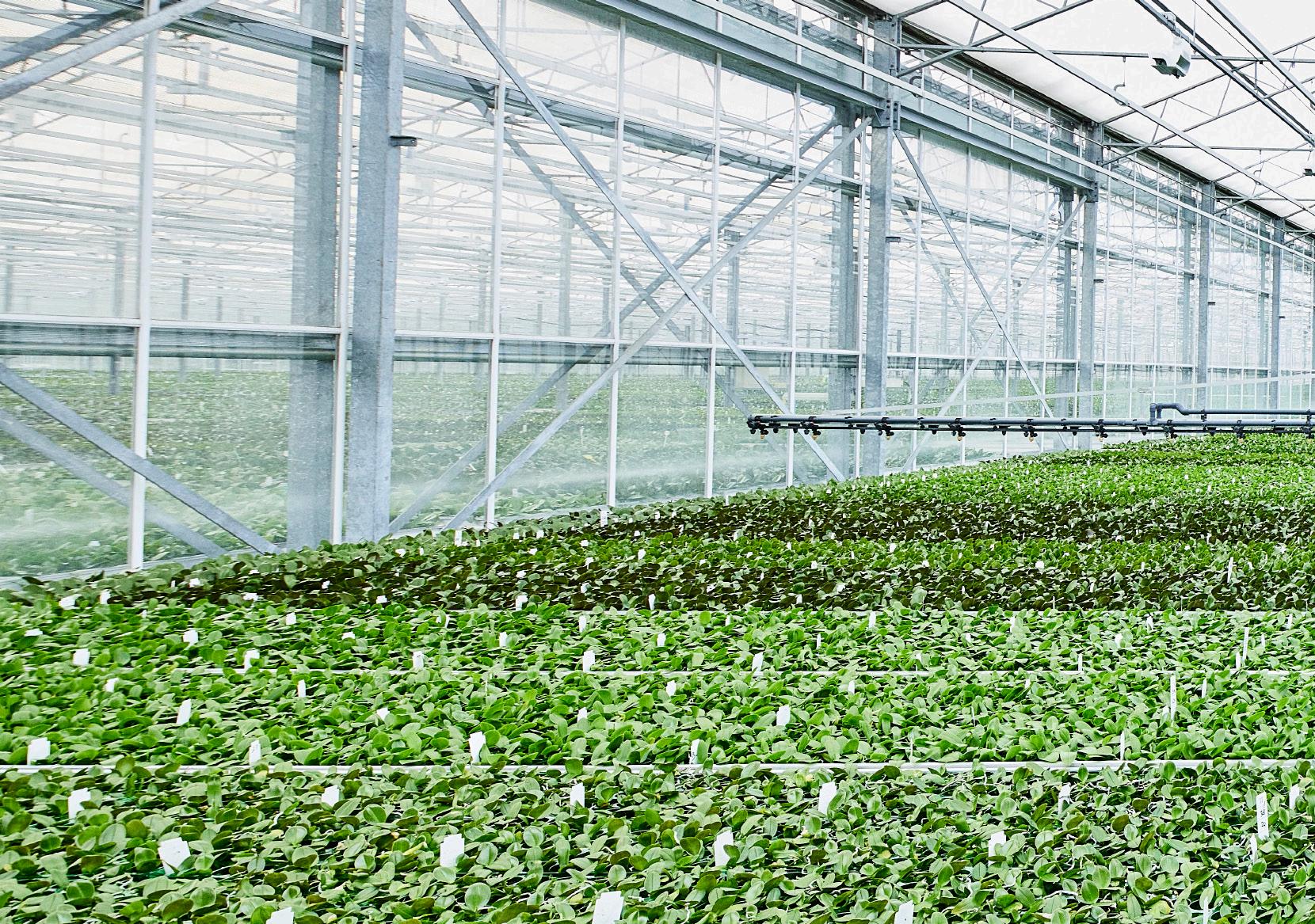BREEDING BUSINESS
June 2023 2 4
Cymbidium Cultivation Tips
6
Peat-free Plugs
Phalaenopsis
Cultivation Tips


June 2023 2 4
Cymbidium Cultivation Tips
6
Peat-free Plugs
Phalaenopsis
Cultivation Tips


Period week 20-30 2023
During this period, there can be too much light for Cymbidium. The greenhouse will be whitewashed for the entire early crop (August-September flowering) and the crop that flowers before 1 November. For the crop that blooms before Christmas, the greenhouse will have to be whitewashed around midsummer’s day, depending on the weather.
Attention: if whitewash is applied too thickly, the average 24-hour temperature may drop too low if the weather is very poor or rainy, and not enough light reaches the crop. This can delay flowering and have a negative impact on branch and flower quality. The best approach is to apply whitewash thinly, and repeat if necessary.
There is still whitewash present while the extremely late crop is growing. After harvesting, it can be wholly or partially removed for regrowth and the production of new shoots. However, if the weather is very bright and sunny, it’s better to wait a while before removing the chalk, or to immediately apply a new, thinner layer.
Whitewash has to be applied because otherwise the daytime temperatures can rise excessively. Evaporation stops when the leaf temperature gets too high (27 °C or more) and the RH drops too low. In very bright light, this can already happen at an ambient temperature of 23 °C. Strong light can raise the leaf temperature to 2 or 3 °C more than the ambient temperature. If the RH is increased, the plant can cope with more light. To elongate the branches well in the very early (September - October flowering) crop, it’s important to keep the daytime temperature in the greenhouse below 25 °C and make sure the 24-hour average does not exceed 20 °C, otherwise branch elongation will stop. That means a delay in flowering of 2 to 4 weeks. Be careful if dark days suddenly follow sunny ones.
On sunny days, the plant is active and can produce a lot of photosynthates, but on dark days, the production of photosynthates drops. It’s therefore important to lower the 24-hour temperature in relation to the cumulative quantity of light. The best and easiest method is to set the night temperature a little lower, but because the night only lasts 8 hours and the day 16 hours, it’s also better to switch to night mode 4 hours earlier. This reduces breathing. If you don’t, the lack of photosynthates can result in the plant relying more on its roots for nutrient uptake which can even kill the roots, and disturbs the water balance.
Pay attention to the amount and frequency of drip irrigation. On hot days when the plant temperature becomes too high (more than 26 °C), the stomata close and the plant no longer absorbs water. This happens between 11:00 and 12:00. You can see this, because the temperature in the greenhouse rises rapidly and the RH drops. Don’t give any more water during this period! When the temperature drops again in the evening, restart drip irrigation. If the climate is maintained within limits during the day by using an outer screen, mist, roof sprinklers, etc., the plants will continue to evaporate and able to absorb water. This stops in the early evening when the plant is full and evaporation stops. Scales are very useful when deciding if watering is necessary. Watering a plant when it doesn’t need it can lead to waterlogging, which can cause the roots to suffocate and die, resulting in Phytophthora.
“Scales are very useful when deciding if watering is necessary”
Floricultura now only uses 100% peat-free plugs for young Phalaenopsis plants. The basic plug used is the Obturo, supplied by Van der Knaap.

“From a social point of view, using peat is causing more and more controversy”
This plug is made entirely of coconut derivatives, and is guaranteed peat-free. There are no disadvantages to leaving out peat components. Coconut is an excellent buffer of nutrients, and plant development meets our high standards.
The coconut used is produced sustainably, and offers an answer to the requirements set by many countries and retailers for peat-free cultivation. In the United Kingdom, for example, legislation was passed last September banning the sale of peat-containing products to consumers from 2024. In Germany, similar legislation is being prepared that aims for a ban from 2025. All this obviously has consequences for the supply of mature plants to these countries.
From a social point of view, using peat is causing more and more controversy, because consumers are very concerned about the erosion of peat stocks, which can still be found in nature as virgin undrained raised bogs.
Legislation and policies are therefore being prepared in various countries in Europe and at various major retailers on restricting peat use. Talk to your customers about the possible effects on your products lines and sales.

After starting with the FibreNeth plug, Floricultura already has about 10 years of experience in growing on coconut plugs. Since mid-2022, cultivation has exclusively used this new Obturo plug. After thorough testing, we can now safely say that peat-free plugs work really well. Moreover, with this plug we no longer have to rely on the plastic baskets we previously used, even though the plug can still be sorted automatically.
“Carry out regular CFU measurements to check for diseases in the irrigation water and the effectiveness of the disinfectant”

Having enough good irrigation water available can be a problem during this period. Keep the basin full with reverse osmosis water if possible. It may not be possible to produce enough of this water, in which case you can lower the membrane retention value to facilitate production.

Keep the basin nice and full to prevent the temperature of the irrigation water rising too far. From 20 °C, the oxygen content drops, and from about 23 °C the water contains too little oxygen. Carry out regular CFU measurements to check for diseases in the irrigation water and effectiveness of the disinfector.
As the days become longer, branch formation becomes more complicated. If the length of the day is reduced to 12 hours by darkening in the 8 weeks before cooling, branch formation will improve. So reduce the cumulative quantity of light for better branch formation! This only applies to the second propagation!
During cooling, the day length can be reduced to 14 to 15 hours. Flower stem formation requires light and a 24-hour average of 19.5 °C. 21 °C during the day, and 18 °C at night (plant temperature). These night values can easily be achieved without cooling until mid-late June. During June, this may gradually change due to rising night temperatures in the summer. The cumulative quantity of light during the cooling period
must always be slightly higher than during propagation. 150 – 170 µmol/m²s is sufficient, and after about 9 to 10 hours of light 100 – 120 µmol/m²s is more than enough. The plant has then depleted its malate supply, resulting in the opening of the stomata. 120 is not better than 100. If light values are high, higher RH values must be maintained, otherwise leaf damage (burning) will occur. Make sure the moisture deficit does not exceed 9 g/m3! A good misting system is therefore important. More light also results in longer branches (= temperature). Too much light can cause buds to dry out. Pay particular attention during days when it’s cloudy in the morning and sunny in the afternoon.

From about mid-July, depending on the weather, botrytis can develop on buds and flowers in plants in bloom. The air contains more moisture during this period, and the probability of condensation forming on flowers in the morning is high, especially after cooler nights. If condensation remains for too long, Botrytis can develop, with white Phalaenopsis at particular risk. Adjust the humidity control in the climate computer and slightly increase the greenhouse temperature before sunrise to remove moisture. Close the screen cloth on clear nights to prevent too much heat radiating out and plants cooling too much. Plants and flowers in the end-stage growth can be dried more quickly after overhead irrigation by opening the lee-side ventilation (maximum 5%) on that day. If misting is used, either turn it off or adjust the settings to increase the moisture deficit to at least 8 g/m3 for the day.

The windows are often open in the summer, so insects can be expected to fly in and you should scout weekly for thrips and mites. In a period of cool/wet weather, everything can seem under control, but if the weather changes, there’s a risk of sudden invasions of insects. Also pay attention to your surroundings if meadows or roadside grass is being mowed, or if a crop is being cleared in nearby greenhouses. This can result in increased insect movements. Various species of thrips occur, but Dichromothrips corbetti is usually the biggest problem in terms of leaf deformity in the youngest leaves. It also causes silver discolouration at the edges of flowers, scarring, and wilted flowers and branches. The WUR thrips recognition card already lists 14 species with detailed photos. In that case, chemical control with Vertimec, Winner or Conserve is necessary. The sooner you act, the sooner the problem will be resolved. Consult your crop protection adviser for authorisations. Swirskii can be used for biological preventive control of thrips. If chemical control has been used, wait at least 2 weeks before releasing beneficial insects. Keep the nursery and surroundings as free from weeds as possible. Scout the crop, and check sticky traps to intervene in time.
“Too much light can cause buds to dry out”
‘inspire! weeks’ by Floricultura

5 to 23 June 2023
ExpoPlantas, Colombia
20 to 22 September 2023
Trade Fair Aalsmeer
7 to 9 November 2023